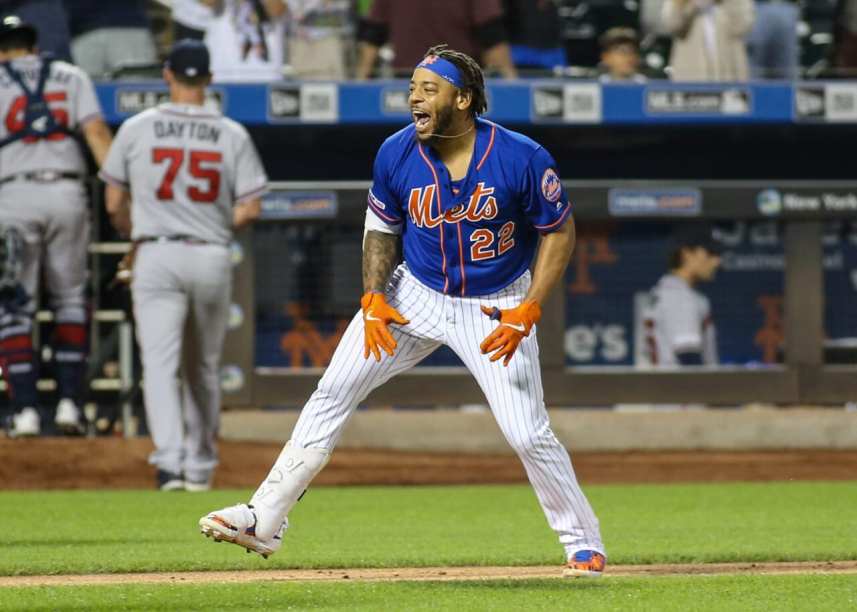
There once was a time where the New York Mets opted to keep Dominic Smith on the bench during the early part of the 2020 season. With Pete Alonso and Yoenis Cespedes clogging potential lineup spots, they could not find playing time for him. Thankfully, Cespedes decided to abandon the team, and Smith became the Mets’ most productive offensive player.
Especially taking into account the next few days, Dominic Smith homering on Jackie Robinson Day is poetic.
How can you not love this guy pic.twitter.com/jXSlDVBZFe
— MetsFanMania (@MetsFanMania) August 28, 2020
The 2019 season was a sneak preview of what Smith was truly capable of at the big league level. In 2020, he put it all together, hitting .316/.377/.616 with 10 home runs, 42 RBIs, and 21 doubles. Smith’s ability to drive in runs made him a staple in the fourth spot of the order. He hit .333 w/RISP and put the same batting average up with two outs and RISP.
Much like his teammate, Michael Conforto, Smith benefitted from a decrease in launch angle to produce more line drives. Smith’s average launch angle dropped from 15.1 degrees last year to 10.8. This allowed Smith to have a 46.7% hard-hit rate, 13.3% barrel rate, and have 39.3% of his batted balls result in line drives.
Complete Hitter
All of those factors equal a hitter who will put himself in a position to hit for average and for power. Smith also became a hitter who forced pitchers to get him out with the fastball. He batted .388 and .351 on breaking balls and offspeed pitches, respectively. Smith had his lowest average and slugging percentage against the fastball, but it was not enough for pitchers to survive by only throwing the hard stuff.
What made Smith such a successful hitter against the secondary pitches is his ability to let it travel in the zone. Smith’s ability to keep his weight back allowed his barrel to remain in the zone to make solid contact no matter how early or late he was. When a hitter does that, he gives himself the best chance to succeed because he can hit the ball in multiple different locations with that one swing.
Defensive Questions
With the two power-hitting first basemen, Smith and Alonso, it is tough to fit them in the lineup. Smith saw some time in left field and was an expected liability there. He had a -5 fielding runs above average and a negative ultimate zone rating. The numbers are much better at first base, and Smith played his natural position more often during the season’s final month. This was when Alonso had issues with his fielding, and the Mets wanted better outfield defense.
It is impossible to mention Smith’s year without mentioning his leadership on and off the field. He helped lead a walk-off between the Mets and Marlins following the protest going on throughout sports. Smith also spilled his emotions, telling his stories and opinions on what was going on in the country. He is one of the most colorful and genuine personalities on the Mets and one of the best teammates they could ask for.
Smith had a fringe-MVP caliber year, would have been an All-Star, and was named a finalist for the Hank Aaron award. Among NL leaders, he finished second in doubles (21), fourth in slugging percentage (.616), fourth in OPS (.993), tied for fifth in RBIs (42), and eighth in batting average (.316). The toughest part for the Mets comes in finding a position for him to settle into for the 2021 season.
2020 Grades On 20-80 Scale (2021 Projection)
Hitting: 80 (70), Cannot get much better than what he produced.
Power: 70 (70), Legitimate power to all fields, and it comes with 40+ double capability.
Run: 30 (30), Not fast but certainly quicker than you would expect.
Arm: 45 (45), Great for first base, but the accuracy surpassed the arm strength in the outfield.
Field: 50 (55), Fields what he gets to in the outfield but has gold glove capability at first base.
Overall: 80 (75), It was an unbelievable season, but doing it for a full year is the final test in his growth.